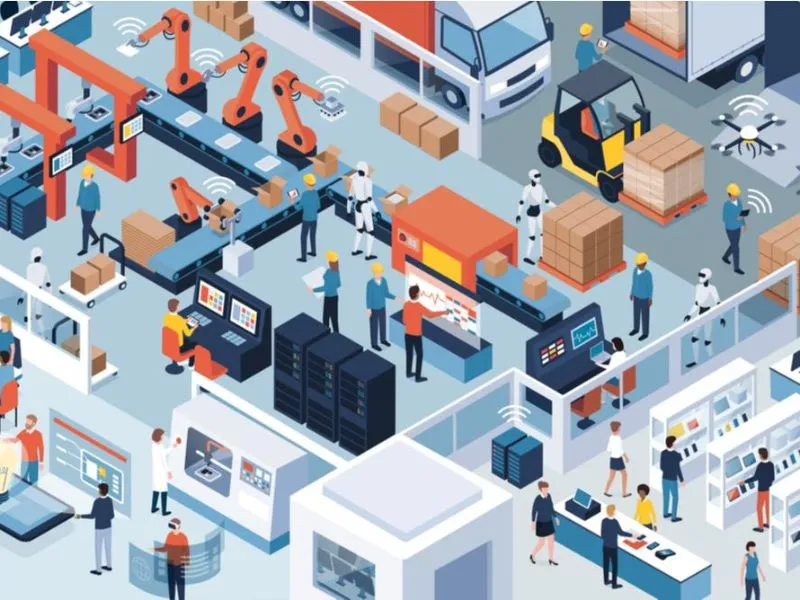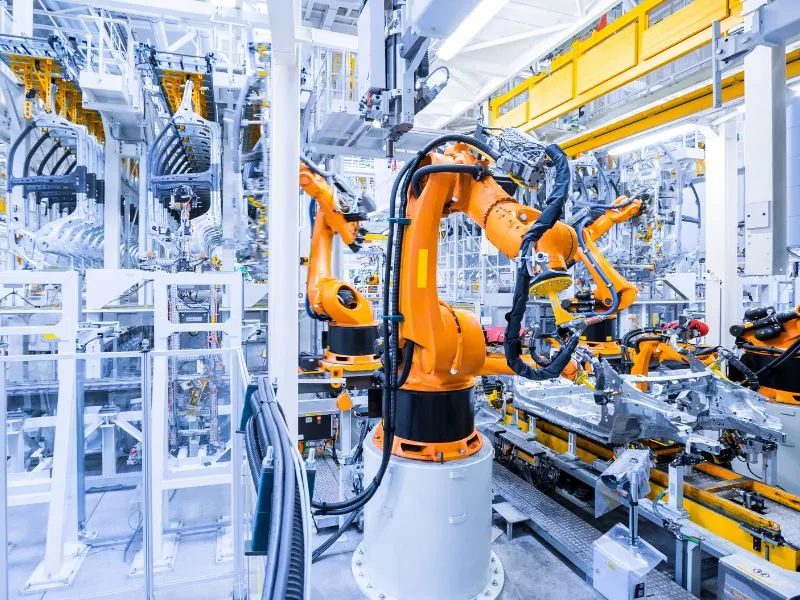Understand the 8 steps in the product manufacturing process
15-08-2025 110
The product manufacturing process plays a core role in the enterprise, determining the quality, productivity and efficiency of the entire production activity. A clear and scientifically built product manufacturing process helps optimize resources, minimize waste and improve competitiveness in the market.
Mục lục
Let's learn about the basic steps in the product manufacturing process, as well as important factors to consider in building an effective process that meets the needs and expectations of customers.
What is the definition of a product manufacturing process?
A product manufacturing process is a series of activities arranged in a logical and scientific order, aiming to turn raw materials, components or semi-finished products into finished products, meeting technical requirements, quality and market demand.
Depending on the goals, characteristics of the products being manufactured as well as resources, businesses follow many different types of manufacturing processes. All focus not only on creating products but also on optimizing the process, ensuring cost savings, time and resources, while improving product quality.

General product manufacturing process in enterprises
In production and business activities, the manufacturing process often includes many different stages. Below are the basic steps that most businesses currently perform.
Step 1. Production planning
This is a fundamental and important step for any production process. This stage helps businesses determine their goals and how to achieve the desired results. The three main contents that need to be implemented in this step include:
Determine production needs
Businesses need to forecast the number of products to be produced in a specific period of time. This is based on the production plan proposed by relevant departments and allocated periodically (week/month/quarter/year). At the same time, it is necessary to analyze the market, including customer preferences, competitor strategies, and business strengths, to ensure that the production plan is consistent with actual needs.
Develop production standards
The product research and development department will be responsible for establishing the necessary standards when the business deploys production. These standards include:
- Raw material standards: Ensure the reasonable use of raw materials, avoiding shortages or surpluses during the production process.
- Scrap standards: Monitor and manage the amount of scrap generated to minimize waste and improve resource efficiency.
- Production cost standards: Record and analyze related costs, thereby evaluating the economic efficiency of the process and optimizing profits.
Planning raw material requirements
To ensure uninterrupted production, businesses need to perform the following steps:
- Determine the amount of raw materials needed for each production stage.
- Check and evaluate the amount of existing materials and components.
- Plan to supplement missing materials or components.

Step 2. Production requirements
The first step in the process is to clearly define production requirements. The relevant department, such as sales or planning, will compile information from orders, market demand forecasts, or new product development strategies. Production requirements include factors such as the number of products to be produced, technical standards, completion times, and required resources. Clarifying these requirements helps ensure that the production process is properly oriented from the start.
Step 3. Production Order
Based on the production requirements, the business issues a production order. This is an official document that describes the production plan in detail, including:
- A list of products to be produced.
- Specific quantities for each type of product.
- Estimated start and completion times.
- Resources to be used, including raw materials, machines, and human resources.
- The production order acts as a “map” guiding the production departments to carry out work according to the proposed plan.

Step 4. Approve the production order
After the production order is created, the next step is approval. This process ensures that the production plan is carefully checked before implementation. The management or supervisory department will consider factors such as:
- The feasibility of the plan.
- The suitability with existing resources.
- The risks that may occur during the implementation process.
- The approval helps the business minimize errors, waste resources and ensure that all aspects have been carefully prepared.
Step 5. Purchase of raw materials and goods
Once the production order has been approved, the business will proceed to purchase the necessary raw materials and goods. The purchasing department is responsible for finding, negotiating with suppliers, and ensuring that the raw materials meet the required quality standards. This process includes the following steps:
- Make a list of raw materials to be purchased, based on production standards.
- Check inventory to determine the amount needed to be replenished.
- Find and select reputable suppliers.
- Negotiate, sign contracts and monitor delivery progress.
- Effective procurement not only ensures that raw materials are always ready for production but also helps businesses optimize costs, minimize waste and disruption.
Step 6. Proceed to production and processing
Once the raw materials are fully prepared, the business begins to carry out production and processing. This is the central stage of the process, where resources are combined to create products. The main tasks in this step include:
- Processing and assembly: Based on technical drawings and production requirements, processing or assembly stages are deployed, from simple to complex.
- Machine operation: Using machinery, equipment and technology to optimize efficiency and ensure product quality.
- Production supervision: The production management department closely monitors each stage to detect and promptly handle arising problems.
- This stage requires synchronous coordination between human resources, machinery and raw materials to ensure production progress and minimize risks.
Step 7. Receiving goods and checking quality
When the product is completed in the production or processing stages, the next step is quality inspection. This helps businesses ensure that products meet established standards before they are released to the market. The inspection process includes:
- Technical inspection: Evaluate technical parameters such as size, function, durability, and other criteria related to the product.
- Appearance inspection: Ensure that the product is free of defects such as scratches, deformation, or aesthetic requirements.
- Testing: Test the product under real-world conditions to check for functionality and safety.
- Products that do not meet standards are returned to the production line for correction, repair, or removal, ensuring that only the highest quality products are accepted.
Step 8. Completing the production process
Once the product has been inspected and confirmed to meet requirements, the production process is completed. This stage includes:
- Packaging: The product is packaged according to standards to protect it during transportation and storage.
- Storage: Finished products are stored in warehouses, awaiting distribution or delivery.
- Handover: Products are transferred to sales departments or customers according to placed orders.
The completion of production not only marks the end of a production cycle but also prepares for the continuation of a new cycle.
Why is it necessary to build a product production process?
Building a product production process plays an important role in the operation and development of a business. A clear, scientific production process brings many benefits such as:
- Ensuring consistency and product quality: The production process helps standardize implementation steps, thereby ensuring that the output product meets consistent quality standards. Controlling each stage in production helps minimize errors and avoid unwanted technical errors.
- Optimize resources and reduce waste: Building a scientific production process helps to effectively use raw materials, human resources and machinery, thereby saving production costs. Minimize waste of time, excess materials, and scrap arising during the production process.
- Increase productivity and production efficiency: A clear process helps departments coordinate smoothly, minimizing waiting time or interruptions during the work process. Workers and employees can easily grasp the work, thereby improving labor productivity.
- Improve management and control capabilities: A well-built production process allows businesses to monitor, measure and evaluate production efficiency at each stage. Easily detect and handle problems arising during the production process.
- Increase adaptability and innovation: A methodical production process helps businesses easily apply new technologies, improve products or change to suit market needs. Create a solid foundation for implementing long-term development strategies.
- Improve reputation and customer satisfaction: Consistent product quality, on-time delivery and competitive prices will help businesses build trust and retain customers.
Example of product manufacturing process reference by industry
Product manufacturing processes in each industry have their own characteristics, reflecting the specific requirements of each field. From the food, textile, to electronic components or construction industries, each process is designed to optimize resources, ensure product quality and meet market demand.
Referring to production processes by industry not only helps businesses better understand how to organize production but also provides practical lessons to improve and develop their production systems.
Below are some illustrative examples of production processes in typical industries, to help businesses have a specific view and apply flexibly in practice.

Pharmaceutical production is a complex process, requiring strict compliance with quality and safety standards

Construction material production process
.jpg)
Packaging production process
Important points to note in the product production process
For the product production process to take place effectively, businesses need to pay attention to a number of important points to ensure quality, optimize resources and meet business goals.
- Define clear goals: Define production goals (output, quality, time, cost). Goals need to be specific, feasible and suitable for business capacity and market demand.
- Resource management: Ensure adequate human resources, machinery, raw materials and necessary input factors. Plan the use of resources to avoid waste or shortages during the production process.
- Build a scientific and logical process: The process needs to be flexible to adapt to changes or specific requirements.
- Strict quality control: Establish inspection standards at each stage. Conduct product testing to ensure quality before releasing to the market.
- Compliance with legal regulations and industry standards: Ensure the production process meets legal and safety standards. Comply with industry quality standards to build credibility with customers.
- Risk management in production: Prepare for interruptions and establish a recovery plan. Respond promptly when risks occur in the production process.
- Employee training: Ensure employees understand the process and have professional skills. Increase periodic training to improve work efficiency.
- Continuous process improvement: Periodic assessment to identify areas for improvement. Apply management methods such as Lean Manufacturing, Six Sigma to optimize the process.
- Ensure coordination between departments: Departments such as production, planning, purchasing and quality control need to coordinate smoothly.
Conclusion
Building and adhering to a professional product manufacturing process not only helps improve quality and reduce costs but also contributes significantly to the sustainable development of the business.
By optimizing each step in the process, businesses can improve productivity, reduce risks and create standard products, thereby enhancing reputation and customer satisfaction. Investing in the production process is one of the most important strategies to ensure long-term success in the market.


